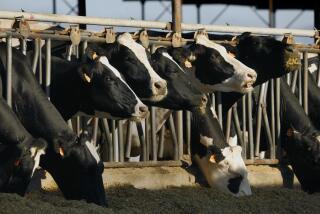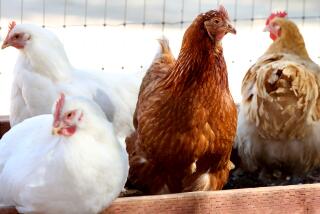Bird Flu Hits Vietnam Right Where It Hurts
HO CHI MINH CITY, Vietnam â To know the effect of avian influenza here, order a steaming bowl of pho ga, or chicken noodle soup -- if you can find one.
Since last year, pho ga has virtually disappeared in this soup-obsessed city, which has more noodle shops than Seattle has espresso bars.
Pho 2000 -- perhaps the nationâs most famous soup cafe owing to a visit by former U.S. President Clinton five years ago -- has literally crossed the dish off its menu. Once commonplace eateries that specialize in chicken soup have closed by the dozen.
âNo one will buy chicken,â said the manager of Pho 24, a trendy downtown soup restaurant. âTry some beef.â
After 18 months of bird flu outbreaks, the economic effect of the epidemic can be seen just about everywhere in Vietnam, from empty soup bowls in the cities to the closure of poultry farms in the hinterlands of the Mekong Delta.
The U.N. Food and Agriculture Organization estimates that Southeast Asia as a whole has suffered about $10 billion in economic losses because of bird flu. Major poultry exporters hit by the outbreaks, particularly Thailand, have suffered the greatest financial losses.
But in Vietnam, poultry is not just an industry, it is a way of life.
About 90% of the nationâs more than 200 million farm birds live in the backyards of subsistence rice growers, laborers and even urban professionals, according to an analysis by the Vietnamese agricultural ministry. Before the flu outbreaks, the vast majority of Vietnamese households, including nearly 70% of the poorest people, sold poultry to supplement their income, according to a World Bank study. Many more sold eggs.
Now, the bird flu epidemic has forced the government to remove chickens and ducks from large swaths of land.
Live poultry has been banned in Hanoi and Ho Chi Minh City, imports have been curtailed and more than 40 million birds have died or been culled by government order.
âIâm very fed up with raising chickens,â said Nguyen Thi Suong, a Mekong Delta farmer.
*
In an epidemic spread by migrating birds, there is no one place that can be identified as its epicenter. The virus has winged its way across Southeast Asia.
The hamlet of Hoi Xuan, about 35 miles southwest of Ho Chi Minh City down bumpy Highway 1, is as good a place to start as any. It is at the heart of Long An province, in the nationâs rice bowl. Of the 40 million birds that have died in Vietnam because of bird flu, nearly 8 million have been from this province. About 85% of its flocks were destroyed last year by the disease known here as cum ga, or chicken flu.
The rice paddies of Hoi Xuan are about 1,000 miles from urban Hong Kong, where bird flu first appeared in 1997. The government there killed every duck and chicken in the territory, more than 1.5 million. The outbreak was contained, but the virus reappeared in 2001 and has surfaced in parts of Southeast Asia every year since.
Culling birds has been the main strategy for preventing the virus from spreading to people. According to the World Health Organization, there have been only 108 officially confirmed human cases, but each one increases the chances of the virus mutating into an easily transmissible form. With little or no immunity to the disease, humans are easy victims.
Since the beginning of 2004, there have been 51 confirmed deaths related to bird flu in the region, according to the WHO.
Health officials suspect that many fatalities are not being reported because disease surveillance in some countries is primitive.
Myanmar, for example, has reported no bird flu this year, even though it borders hard-hit Thailand. Cambodia, which lies between Vietnam and Thailand, has reported only three deaths.
Most of the deaths, 36, and confirmed infections, 68, have been reported in Vietnam, which may reflect the countryâs more developed health reporting system.
Among waterfowl, the virus, formally known as avian influenza H5N1, is relatively innocuous, often causing few noticeable symptoms. For chickens, however, it is a stunning killer.
Suongâs husband, Ho Van Nghia, recalled feeding his chickens one day and returning a few minutes later to see the birds falling down in front of him.
âThe family was very frightened,â said the 41-year-old chicken farmer in Hoi Xuan.
The government ordered all of the surviving chickens burned.
Nghia made a makeshift pyre. The stench was overwhelming, so he spent six hours suffocating the birds by stuffing them into plastic bags, then threw the bags into a hole.
He lost 1,000 chickens. The family naively ate some of the infected birds. Fortunately they were thoroughly cooked and no one became ill.
Nghia took out loans and started over with 2,500 birds. In January, exactly one year after the first outbreak, bird flu hit again. All of his birds died or were culled.
The government paid him the standard 32 cents per culled bird, a fraction of their value. Nghia figures he has lost more than $5,000 from bird flu, more than 10 times the average annual income.
He has temporarily given up on chickens. He now has 70 pigs, held in the former chicken pen a few steps behind his home. But pigs are less profitable, Suong said, because of volatile pork prices and the time and expense needed to raise them to maturity.
So he plans to raise chickens again someday.
His own familyâs habits seem to suggest that it could be a long wait. They eat pork and fish these days, rarely touching chicken, in part because of fear of the flu.
âVietnam has suffered too many things -- the war, poverty,â Nghia said. âNow that we finally have gotten a bit better life than before, we have more suffering.â
*
For as long as people can remember, a narrow three-block stretch of Tran Chanh Chieu Street has been Ho Chi Minh Cityâs bustling poultry market.
Itâs near the center of town, and in its heyday was a riot of chickens, ducks and geese bound at the feet. Retailers bought tons of live poultry a day, joined by intrepid bargain hunters looking for a choice dinner.
âThe market operated around the clock, 24 hours,â said Nguyen Thi Le, a live-chicken seller in Ho Chi Minh City who no longer has any to sell.
Since the government banned live birds from Ho Chi Minh City in February, only a few lonely vegetable sellers in conical straw hats spread their blankets on the street, still encrusted with bird debris.
âIâm not sure if the ban was such a good idea,â Le said as she squatted forlornly on the sidewalk.
Now she sells fish, reluctantly.
The loss of poultry from Ho Chi Minh City has sparked a chain reaction.
Le said the market had traditionally supported dozens of bird sellers from the cityâs outskirts and the Mekong Delta, who found ready buyers paying good prices in the more affluent city. Most of those sellers have retreated to their farms, unable to find new jobs.
Shops that depended on foot traffic from the market have closed. Heavy metal gates seal empty storefronts.
On a nearby street corner, motorcycle taxi drivers smoked and socialized as they trolled for fares. Until recently, someone always needed a ride home with a clucking-fresh dinner hanging by the feet.
âBusiness is bad,â one driver lamented.
Humble soup vendors still squat by steaming charcoal-heated pots at their sidewalk kitchens throughout the city, but now they stir vegetables, dried shrimp or pork into the aromatic broth.
The Chao Vit Thanh Da area of the city along the Saigon River specialized in duck restaurants and stores selling ducks. Many have disappeared.
Even outside Ho Chi Minh City, where live markets are still allowed, birds are harder to buy these days.
In the sprawling Ha Tien central market near the border with Cambodia, a once-teeming poultry market with dozens of stalls has been reduced to about 20 lethargic ducks and chickens.
âThese ducks look very healthy,â said their owner, Danh Thi Hong, as she sat in a nearby hammock, dodging passing hogs.
A steady stream of shoppers ignored the animals.
*
The chicken situation has given a boost to some segments of the economy.
âPeople now prefer eating fish,â explained one fishmonger in Long An province. âMy business is up.â
A few nearby meat sellers agreed as they waved flies off fatty cuts of beef and pork: Business was brisk.
But many people are ignoring the governmentâs restrictions.
A kind of poultry underground has emerged. Chickens are smuggled from Cambodia and China across rivers and dirt trails.
The internal dragnet to keep birds out of Ho Chi Minh City is enforced by inspection posts at main roads. At the sole checkpoint from the Mekong Delta, bored inspectors sat and smoked beside the tiny plywood and corrugated-metal booth next to a roadside soda stand.
âWhenever a truck or car passes here with live animals, they all have a permission paper. It means that the animalsâ blood has been tested,â said Pham Van Tung, the government veterinary inspector at the checkpoint.
But only six or seven trucks stop each day, fewer than 2,000 birds in all. Only a few suspect birds have been detected this year, smuggled by motorcycle, Tung said.
Although Ho Chi Minh Cityâs bird markets have been emptied, a quick jaunt off the main streets revealed many chickens still hiding in the city, waiting to be eaten or sold. Millions of birds are hidden in plain sight where they have always been: in the backyards of people who keep a few chickens or ducks to feed their families.
A few restaurant owners, confident in the governmentâs inability to catch them, brazenly display birds in their store windows to entice those desperate for a taste.
The government has been encouraging consumers to buy butchered chicken, certified by the government as flu-free, from modern supermarkets. Itâs not a convenient solution for most people in rural areas, since supermarkets are relatively rare, as are refrigerators in which to store butchered meat.
In Ho Chi Minh City, KFC has been buying poultry from certified farms for its restaurants and has doubled its sales since last year, said John Pain, the companyâs Asia regional manager based in Singapore.
When bird flu hit early last year, the Vietnamese outlets of the American fast-food chain briefly suffered the indignity of serving fish instead of chicken.
Now theyâre making a comeback. Other restaurants in town may be equally safe, but KFCâs Western aura seems to engender confidence. Many residents of Ho Chi Minh City believe that KFC imports U.S. or European birds, said Pham Thai, an interpreter who occasionally indulges in a U.S.-style chicken fix.
âWe donât even worry about what we are eatingâ at KFC, he said.
But Thai lamented that many people still had âa very heavy nostalgic feelingâ for traditional fresh chicken dishes.
âOh my beloved,â he said, repeating an old Vietnamese saying, âlife without you is like pho without broth.â
More to Read
Sign up for Essential California
The most important California stories and recommendations in your inbox every morning.
You may occasionally receive promotional content from the Los Angeles Times.









